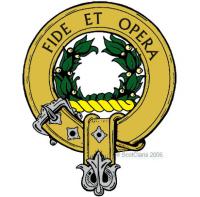
Clan MacArthur
The legends of King Arthur are well known and historically contradictory. From the Welsh-speaking areas of Strathclyde (in which Glasgow now lies), Rheged and Gododdin (in which Edinburgh now lies), the earliest surviving Scottish poem tells of the resistance leader Arthur fighting against the English of Northumbria when they defeated Gododdin. When Scotland’s Welsh-speaking Kingdoms were wiped out the language returned to Wales and Cornwall.
Arthurian legend was taken with it to be transplanted and developed all over these areas. Arthur’s Seat, however, remains solidly beside Edinburgh. An ancient Celtic couplet ran, ‘the hills and streams and MacAlpine but whence came forth MacArthur?’ so old is the name.
The MacArthurs fought beside Robert the Bruce for Scotland’s independence and gained mid-Argyll lands from the King’s opposers as a reward. From here the MacArthurs prospered and spread, growing into two successful houses - the MacArthurs of Loch Awe and the MacArthur Campbells of Strachur.
In the thirteenth century a MacArthur married the heiress of Duncan mac Duibhne.
Later the Clanh Ua Duihne carried the nickname Cam beul. So through the MacArthurs came the Campbells.
When James I returned from his English imprisonment his wrath fell upon the MacArthurs among others. Through a wave of executions and estate seizures the MacArthurs were stunted and the Campbells became the predominant race north of Glasgow.
In 1567 Duncan MacArthur and his son, of the Loch Awe family, became the victims of their own success when jealousy drove neighbours to drown them in the loch.
A great number of MacArthurs emigrated from Scotland in the years following disastrous Culloden in 1746, choosing to restart in America, Canada, Australia and the West Indies.






